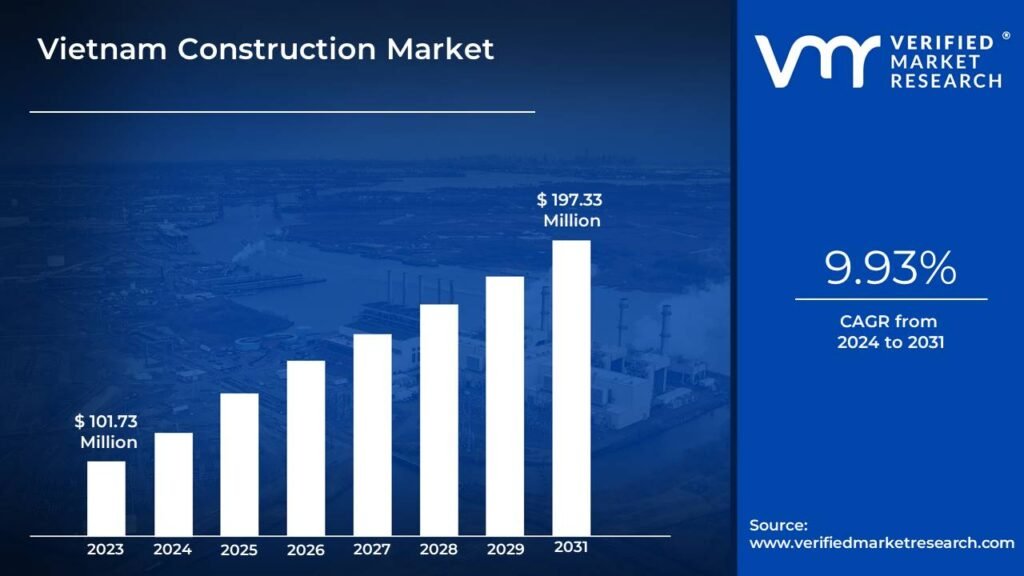Vietnam’s construction industry is set to grow significantly in 2024, thanks to new technologies, fast urbanization, and government reforms. The Vietnam Construction Market Trends 2024 are reshaping how the industry operates, opening new opportunities for businesses. Let’s take a look at the key trends driving this growth!

Embracing New Technologies
Technology is changing the construction landscape in Vietnam. Companies are using advanced tools to work faster, safer, and more efficiently.
Some notable trends include:
- Building Information Modeling (BIM): BIM is a digital tool that helps architects and engineers create detailed 3D models of buildings. This technology is becoming popular in Vietnam, especially for large infrastructure projects. By using BIM, companies can plan better, reduce errors, and avoid delays, which saves time and money.
- Drones and IoT: Drones are also making a big impact. They fly over construction sites to conduct surveys and inspections, giving real-time data to project managers. The Internet of Things (IoT) is also gaining traction. IoT sensors monitor equipment and ensure worker safety, improving overall site management and boosting productivity.
- Automation and Robotics: Automation is starting to address Vietnam’s skilled labor shortage. Automated machines and robots can handle repetitive tasks, allowing workers to focus on more complex jobs. This not only speeds up projects but also helps reduce labor costs.
Rising Urbanization and Housing Needs

Vietnam’s cities are growing rapidly, creating a high demand for new homes, especially in major urban areas and industrial zones. The government plans to increase the urban population from 40% to 45% by 2030, building more housing to accommodate millions of people.
To meet this demand, the government aims to build one million social housing units between 2021 and 2030. In 2024, the Ministry of Construction plans to build 130,000 of these units. This massive housing push is crucial for providing affordable homes and supporting the needs of a growing population.
Government Reforms and Infrastructure Investment
The Vietnamese government is playing a key role in boosting the construction sector through major policy reforms and infrastructure projects. Some of the reforms include:
- Transport Infrastructure: One of the government’s main goals is to improve the country’s transportation network. By 2030, Vietnam plans to build nearly 5,000 kilometers of expressways, making travel faster and more efficient. Additionally, eight new metro lines are planned for Ho Chi Minh City by 2035, which will help reduce traffic and improve public transport.
- Energy and Utilities: Vietnam is also investing heavily in renewable energy to make the country greener. The government aims to increase the share of renewable energy to 23% by 2025. Plans include generating 20 million tonnes of hydrogen per year by 2050, creating opportunities for construction companies working in the sustainable energy sector.
- Foreign Direct Investment (FDI): Vietnam is attracting more foreign investment due to policy reforms that make the market more accessible. In 2023, foreign investment rose by 32.1%, a strong recovery after a decline in 2022. Improved rules for foreign ownership and a friendly business environment are drawing international investors, further boosting construction activities.
Challenges Ahead
Even with the favorable prognosis, obstacles are still present in the construction industry. Uncertainty in the economy and high labor and material costs might affect project budgets and schedules. Construction companies need to stay adaptable, plan carefully, and embrace new strategies to navigate these obstacles.
The Vietnam Construction Market Trends 2024 paint a bright picture of the industry’s future. With new technologies, rapid urbanization, and supportive government policies, Vietnam’s construction sector is set to thrive. By staying innovative and aligning with these trends, construction companies can seize opportunities and help drive the country’s growth. The road ahead looks promising for those ready to adapt and grow with the market.

